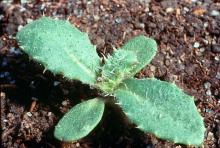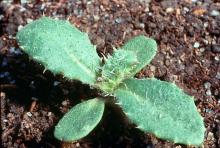2,4-D
Selective treatment in grain and grass crops
Rate 1 to 1.5 lb ae/A
Time Apply at the early bud stage of thistle. May require repeated applications.
Remarks Do not apply to grass or grain crops before tiller stage or from early boot to dough stage. The 1.5 lb/A rate can injure wheat.
Caution Avoid drift to sensitive crops.
Site of action Group 4: synthetic auxin
Chemical family Phenoxy acetic acid
2,4-D or MCPA + dicamba
Rate 1 lb ae/A 2,4-D or MCPA and 0.125 lb ae/A dicamba
Time In wheat or barley, apply after crop begins tillering and before boot stage. May also be applied in stubble or fallow.
Remarks MCPA is usually more effective on Canada thistle. Results are best if applied to actively growing thistles.
Site of action (all) Group 4: synthetic auxin
Chemical family (2,4-D and MCPA) Phenoxy acetic acid; (dicamba) Benzoic acid
bentazon (Basagran)
Selective in corn, dry beans, peas, and mint
Rate 0.75 to 1 lb ai/A
Time When thistle is 6 to 8 inches tall. If needed, apply again in 10 to 14 days.
Remarks Light leaf speckling may occur, but crop plants generally outgrow this within 10 days. Canada thistle must be thoroughly covered. Use at least 20 gal/A of water and at least 40 psi by ground. For aerial application, use at least 5 gal/A of water and a maximum of 40 psi.
Caution Do not use near water. Avoid applying during drought or unseasonably cold weather. Expect unsatisfactory results if daytime temperatures do not reach at least 70°F during the week after applying.
Site of action Group 6: photosystem II inhibitor
Chemical family Benzothiadiazole
chlorsulfuron (Glean)
Barley, oats, wheat
Remarks To suppress Canada thistle only. See sections in this handbook on barley, oats, and wheat for use instructions.
Site of action Group 2: acetolactate synthase (ALS) inhibitor
Chemical family Sulfonylurea
chlorsulfuron + metsulfuron (Finesse)
Barley and wheat
Remarks To suppress Canada thistle only. See sections in this handbook on barley and wheat for use instructions.
Site of action (both) Group 2: acetolactate synthase (ALS) inhibitor
Chemical family (both) sulfonylurea
clopyralid (Stinger)
Rate 0.09 to 0.5 lb ae/A (0.25 to 1.33 pints/A). Labeled rates vary by crop.
Time Apply to actively growing weeds. For Canada thistle, apply after most basal leaves emerge but before bud stage.
Remarks For most effective control, apply as a broadcast treatment to the entire infested area.
Caution Consult label for crop rotation restrictions before using these products. Several crops may be injured up to 4 years after application. Consult labels for registered use sites. Stinger is registered for use on field corn, sugar beets, Conservation Reserve Program (CRP), grass seed, rangeland, pasture, Christmas tree, small grains, and non-crop areas.
Site of action Group 4: synthetic auxin
Chemical family Pyridine
clopyralid + 2,4-D amine (Curtail)
Rate 1 to 2 quarts/A Curtail. Maximum rate depends on crop.
Time Apply 2.66 pints/A formulated product to wheat or barley after crop begins tillering and before boot stage. The 2-quart rate can be used in fallow and in grass seed crops. Canada thistle should be in the rosette to prebud growth stage.
Remarks Apply in warm weather when weeds are actively growing and soil moisture is adequate for active plant growth.
Caution Consult label for crop rotation restrictions before using product. Several crops may be injured up to 4 years after application. Do not permit dairy animals or meat animals being finished for slaughter to forage or graze treated grain fields within 1 weeks after treatment. Do not harvest hay from treated grain fields.
Site of action (both) Group 4: synthetic auxin
Chemical family (clopyralid) pyridine; (2,4-D) phenoxy acetic acid
dichlobenil (Casoron)
Selective in trailing berries, fruit trees, grapes, and ornamentals
Rate 4 lb ai/A in berries; 4 to 6 lb ai/A in fruit trees and grapes
Time Apply in winter or spring before active growth of crops or thistle before a rainy period to allow for activation and to avoid volatilization.
Remarks Apply midwinter immediately before a cold rain to reduce volatility and enhance weed suppression. Weigh and distribute uniformly exact quantities over precisely measured areas. Oregon results over 9 years suggest that perennial weeds can be suppressed with 4-, 3-, and 2-lb ai/A rates applied during 3 consecutive years. Grazing livestock is prohibited. (Inhibits cellulose and cell wall formation.)
Site of action Group 20: inhibits cell wall synthesis Site A
Chemical family Nitrile



